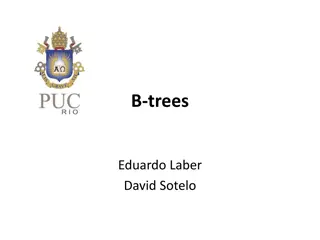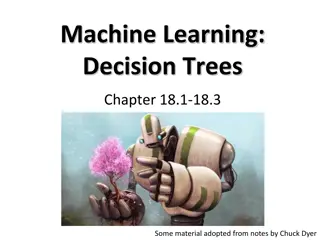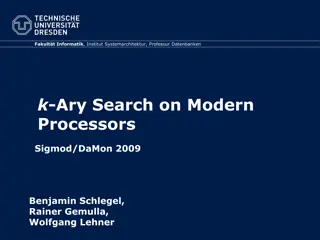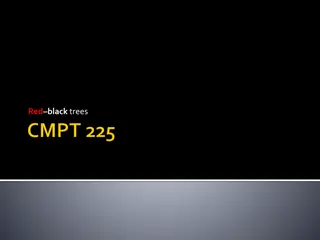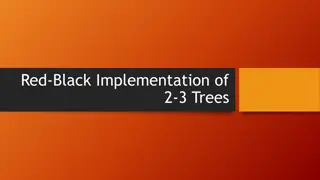Understanding Red-Black Trees for Balanced Search Structures
Red-black trees are balanced binary search trees ensuring a maximum height of O(log n). They maintain balance properties by coloring nodes red or black, with operations such as search, insertion, deletion efficiently managed in O(log n) time. Red-black trees exhibit guaranteed height bounds for improved performance in dynamic set structures.
Download Presentation

Please find below an Image/Link to download the presentation.
The content on the website is provided AS IS for your information and personal use only. It may not be sold, licensed, or shared on other websites without obtaining consent from the author. Download presentation by click this link. If you encounter any issues during the download, it is possible that the publisher has removed the file from their server.
E N D
Presentation Transcript
Balanced Search Trees Balanced search tree: A search-tree data structure for which a height of O(lg n) is guaranteed when implementing a dynamic set of n items. Examples: AVL trees 2-3 trees B-trees Red-black trees Treaps and Randomized Binary Search Trees
Red-black trees A binary search tree with an extra bit of storage per node: it s color Color can be red or black Tree is approximately balanced such that no path is more than twice as long as any other Properties: Every node is red or black The root is black Leaves are nil nodes that are black If a node is red then both its children are black For each node, all simple paths from the node to descendant leaves contain the same number of black nodes
Example of a red-black tree Every node is red or black The root is black Leaves are nil nodes that are black If a node is red then both its children are black For each node, all simple paths from the node to descendant leaves contain the same number of black nodes
Height of a red-black tree Theorem A red-black tree with n internal nodes (non-nil, nodes with keys) has height h <= 2lg(n+1) Intuitive argument: Merge red nodes into their black parents
Height of a red-black tree Resulting tree is a 2-3-4 tree where each node has 2, 3, or 4 children The 2-3-4 tree has uniform depth h of leaves
Height of a red-black tree Since at most half of the leaves on any path are red we must have h >= h/2 Note that the number of leaves in each tree is n+1 n+1 >= 2h (from the black height of each node) lg(n+1) >= h >= h/2 h < 2lg(n+1)
Corollary All the query operations take O(lg n) time on a red-black tree with n nodes Search Min Max Successor Predecessor We can also insert and delete in O(lg n) time but it requires some trickier operations to maintain the red-black tree properties Must change colors and perform rotations
Rotations A rotation takes O(1) time while maintaining the ordering of the keys and the BST property
Insertion Idea Insert new node as normal to a BST. Color it red and then recolor/rotate up the tree if there are any violations. Example: Insert x=15
Insertion Example Recolor 11 to black, 10 to red, the right-rotate 10 with 18
Insertion Example Recolor, left-rotate 10 with 7 and recolor
Analysis Code is a bit messy with special cases see online for details Can perform O(1) rotations moving up the tree for O(lg n) insertions Overall O(lg n) runtime Deletion also O(lg n) time Similar special cases to consider
Randomized Data Structures If we have random input data then we get expected good performance on binary search trees BUT on particular inputs we can get bad behavior Idea: When you can t randomize the input, randomize the data structure Gives expected random behavior, which is O(lg n) for BST, on any input!
Enter... the TREAP Tree + Heap, hence TREAP Both a BST and Heap are merged together. No array like we did previously with the heap, instead it is part of the node of the BST Invented in 1989 by Aragon and Seidel Why? High probability of O(lg n) performance for any input Code is much simpler than red-black trees Perhaps the simplest of all balanced BST s Can implement without recursion for extra speed
Treap Treaps maintain a key value and a priority value for each node binary search tree property maintained for the keys heap property maintained for the priority value The heap values are randomly assigned Key: 10 Priority: 0.97 Key: 5 Key: 15 Priority: 0.85 Priority: 0.31 Key: 2 Key: 8 Key: 12 Priority: 0.12 Key: 85 Priority: 0.76 Priority: 0.24 Priority: 0.15 Key: 97 Priority: 0.11
Treap Insert Choose a random priority (in our example between 0-1) Insert like normal into the BST Rotate up until heap order is restored Note that rotations preserve the heap property AND the BST property! Example, insert key=20, priority=0.5 Key: 5 Key: 5 Priority: 0.31 Priority: 0.31 Key: 2 Key: 8 Key: 2 Key: 8 Priority: 0.24 Priority: 0.15 Priority: 0.24 Priority: 0.15 Key: 20 Priority: 0.5 Key: 4 Key: 4 Priority: 0.13 Priority: 0.13
Insert Example Rotate Key: 20 Priority: 0.5 Key: 5 Priority: 0.31 Key: 5 Key: 20 Priority: 0.5 Key: 2 Priority: 0.31 Priority: 0.24 Key: 8 Key: 4 Key: 8 Key: 2 Priority: 0.15 Priority: 0.13 Priority: 0.15 Priority: 0.24 Key: 4 Priority: 0.13 Shape of the tree fully specified by random priorities No bad inputs, only bad random numbers!
Delete To delete a node: Find the node X to delete via BST search If X is a leaf, just delete it If X has only one child, rotate the child up and delete X If X has two children, rotate with child that has the largest priority, maintaining the BST property with the key, and then recursively delete X
Delete Example Delete Key 15 Key: 10 Priority: 0.97 Key: 5 Key: 15 Priority: 0.85 Priority: 0.31 Key: 2 Key: 8 Key: 12 Priority: 0.10 Key: 85 Priority: 0.76 Priority: 0.24 Priority: 0.15 Key: 97 Priority: 0.11 Rotate with Key 85 Priority 0.76
Delete Example Key: 10 Priority: 0.97 Key: 85 Priority: 0.76 Key: 5 Priority: 0.31 Key: 97 Priority: 0.11 Key: 15 Priority: 0.85 Key: 2 Key: 8 Priority: 0.24 Priority: 0.15 Key: 12 Priority: 0.10 Rotate with Key 12 Priority 0.10
Delete Example Key: 10 Priority: 0.97 Key: 85 Priority: 0.76 Key: 5 Priority: 0.31 Key: 97 Priority: 0.11 Key: 12 Priority: 0.10 Key: 2 Key: 8 Priority: 0.24 Priority: 0.15 Key: 15 Priority: 0.85 No children, just delete Key 15
Delete Example Key: 10 Priority: 0.97 Key: 85 Priority: 0.76 Key: 5 Priority: 0.31 Key: 97 Priority: 0.11 Key: 12 Priority: 0.10 Key: 2 Key: 8 Priority: 0.24 Priority: 0.15
Treap Applet https://www.ibr.cs.tu-bs.de/courses/ss98/audii/applets/BST/Treap- Example.html Java applet so kind of hard to run nowadays (could still run in IE after editing Java Console permissions)
Treap Summary Implements Binary Search Tree At a more abstract level, a Dictionary fast to insert, retrieve, delete Insert, Delete, and Find in expected O(log n) time Worst case O(n) but extremely unlikely Memory use O(1) per node Relatively simple to implement, much less overhead than red-black or AVL trees



